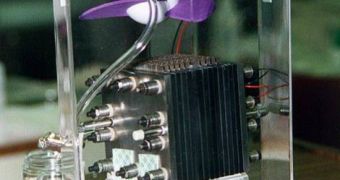Fuel cell technology holds the most promise as the next big thing in energy storage, as it is far more effective than conventional batteries in providing electrical current to electric cars and other such machines. However, at this point, it is still not quite ready for implementation, and the cells' rather bulky size makes it impractical. Now, researchers at the University of Georgia (UGA) have taken the first step towards producing small biological fuel cells, when they have grown molecular wire brushes.
The next-generation of fuel cells, very reduced in size, could eventually be used to power up prosthetic limbs, pacemakers and cochlear implants, as well as other such electronic devices implanted in the human body.
In what editors call “a significant breakthrough for nanotechnology,” researchers from UGA wrote in the June issue of the journal Chemical Communications that the find could lead to the rapid development of the small-scale fuel cell industry. In charge of the research was Jason Locklin, a UGA chemist, working together with graduate students Nicholas Marshall and Kyle Sontag.
“The molecular wires are actually polymer chains that have been grown from a metal surface at very high density. The structure of the film resembles a toothbrush, where the chains of conjugated polymers are like the bristles. We call these types of coatings polymer brushes. To get chains to pack tightly in extended conformations, they must be grown from the surface, a method we call the 'grafting from' approach,” Jason Locklin explains. He is the beneficiary of a joint appointment in UGA's Franklin College of Arts and Science, and in the Faculty of Engineering.
The molecular wire brushes are entirely constructed from chains of thiophene and benzene, which are oftentimes used as solvents. The aromatic molecules were attached to metal surfaces as ultra-thin films, EurekAlert reports. “The beauty of organic semiconductors is how their properties change, based on size and the number of repeating units,” the researcher, also a member of UGA's Nanoscale Science and Engineering Center, says. Speaking about the thiophene molecules, he adds that they are insulators in themselves, but that “by linking many thiophene molecules together in a controlled fashion, the polymers have conducting properties.”
“This technique gives us the control to systematically vary polymer architecture, opening up the possibility for various uses in electronic devices such as sensors, transistors and diodes. The film itself might be used in transistors – or in photovoltaic devices such as solar cells,” the expert concludes.

 14 DAY TRIAL //
14 DAY TRIAL //